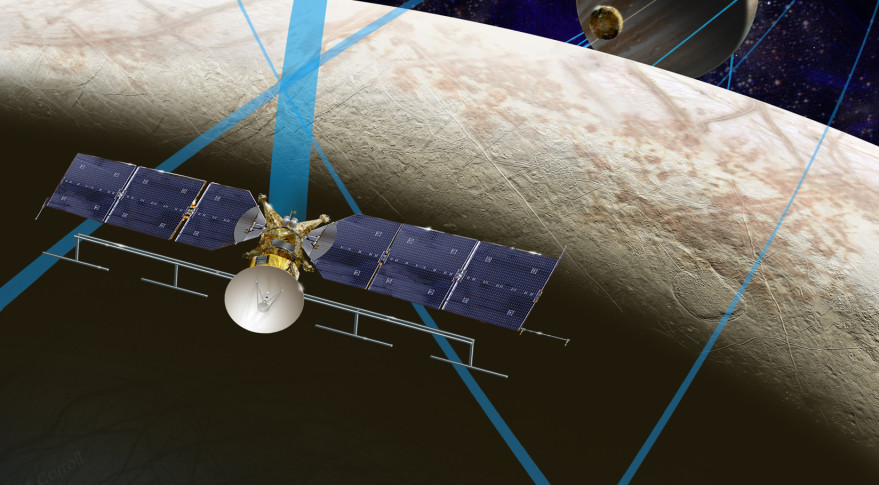NASA Weighing Dual Launches of Europa Flyby Probe and Lander

WASHINGTON — Faced with a congressional mandate to add a lander to a planned mission to Jupiter's icy moon Europa, NASA is considering launching the lander separately from the main mission.
In discussions Feb. 1 at a meeting of NASA's Outer Planets Assessment Group in San Antonio, Texas, agency officials said they are considering how to add a lander to a mission under development to make multiple flybys of Europa, even though the lander will weigh significantly more than the main "clipper" spacecraft.
Curt Niebur, outer planets program scientist at NASA Headquarters, said at the meeting that the biggest challenge of adding the lander to the Europa mission is its mass: about 17,600 lbs. (8,000 kilograms), to accommodate the propellant needed to land the spacecraft softly on the surface. He added that estimate was "very rough" based on the limited studies of lander concepts to date. By comparison, the clipper spacecraft alone would have a mass of only about 11,000 lbs. (5,000 kg). [Europa May Harbor Simple Life-Forms (Video)]
That additional mass would drive the selection of the launch vehicle, requiring the use of NASA's in-development Space Launch System megarocket. "If we co-manifest the lander and clipper, we're only on SLS," he said. "It's still a slow boat, so to speak: you'd still do inner solar system gravity assists."
NASA planning for a Europa clipper alone has examined using an Atlas 5 launch and flybys to reach Europa, or an SLS launch on a direct trajectory. The SLS would be more expensive than an Atlas 5, but the direct trajectory would allow the mission to reach Europa several years sooner.
Niebur said an alternative under study would be to launch the clipper spacecraft and the lander separately. "It's an option that we've been kicking around, and we need to make a decision on that preferably soon," he said.
Splitting the mission into two launches could allow the clipper spacecraft to remain on a fast track. Niebur said that, given current funding trends where Congress has allocated significantly more for the mission than NASA has requested, a clipper spacecraft alone could be technically ready for launch as soon as 2022.
Get the Space.com Newsletter
Breaking space news, the latest updates on rocket launches, skywatching events and more!
"If you put a very capable lander on there, I think that's going to slow things down a bit," he added. "Do you put them all on the same spacecraft and launch them on the same rocket, or do you split them onto separate rockets? That's also an option we could consider."
Splitting the clipper and lander spacecraft, though, could run afoul of the congressional language that is forcing NASA to consider flying the lander in the first place. The fiscal year 2016 omnibus spending bill passed in December provided NASA with $175 million for work on a Europa mission, with direction that such a mission consist of "an orbiter with a lander" and "plan for a launch no later than 2022" on an SLS.
Robert Pappalardo, the Europa project scientist at NASA's Jet Propulsion Laboratory in Pasadena, California, said there is a "strawman" schedule for accommodating a Europa lander on the planned clipper mission, although he did not disclose it at the meeting. "That said, the plan is for the clipper portion, the multiple-flyby portion, to go full steam ahead," he said. That includes holding the mission's next major review, a system requirements review, this summer regardless of any decision to add a lander.
Niebur said that, separate from the discussion about a lander, NASA was examining several smaller "augmentations" to the clipper spacecraft. One example he mentioned is a cubesat-sized spacecraft that would fly through plumes of water ice ejected by Europa. Other additions to the clipper spacecraft could address studies of Europa's gravitational field.
The current spacecraft design has about 550 lbs. (250 kg) of spare mass to support those or other additions to the clipper spacecraft separate from the lander. Those augmentations, he said, would not affect the primary science mission of the main spacecraft and its suite of 10 instruments NASA announced last year.
"Whatever we do in terms of these enhancements, I want to stress that we are fully committed to the multiple-flyby mission," he said. "For any other decisions on enhancements, our drivers are going to be to protect the science of the multiple flyby mission."
This story was provided by Space News, dedicated to covering all aspects of the space industry.
Join our Space Forums to keep talking space on the latest missions, night sky and more! And if you have a news tip, correction or comment, let us know at: community@space.com.

Jeff Foust is a Senior Staff Writer at SpaceNews, a space industry news magazine and website, where he writes about space policy, commercial spaceflight and other aerospace industry topics. Jeff has a Ph.D. in planetary sciences from the Massachusetts Institute of Technology and earned a bachelor's degree in geophysics and planetary science from the California Institute of Technology. You can see Jeff's latest projects by following him on Twitter.
